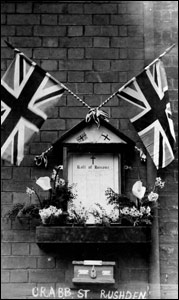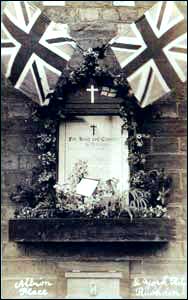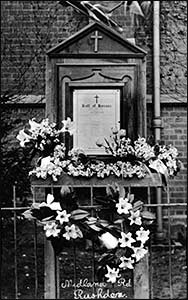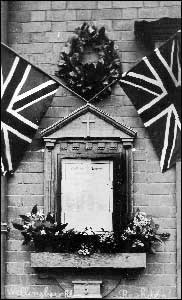Rushden Echo, 24th November 1916, transcribed by Kay Collins
Street War Shrines at Rushden - Representative Meeting
Proposed Roll of Honour
A meeting was held at the Athletic Club, Rushden, on Wednesday, to discuss the provision of âStreet War Shrinesâ for Rushden. Mr. G. R. Turner was voted to the chair, and there were present representatives of the various working menâs organisations of the town.
The Chairman said he would gladly help in any way.
Mr. Fathers outlined a scheme for the erection of War Shrines in the streets of the town. He proposed they should consider a house-to-house visitation to obtain the names of every-one serving.
He proposed the erection a small oak-framed Rolls of Honour in a prominent place in each street and the appointment of a small committee for each street to keep the secretary posted as to alterations which could be made periodically.
He thought that if they obtained one 'Shrine' they would soon be encouraged to go on with a systematic canvass of the town.
The Chairman asked the meeting to consider whether they should erect one big 'shrine' in a public place. He thought the 'Street Shrines' could be only a temporary measure, for they must have a really handsome permanent memorial at the end of the war.
Mr. Beardsmore thought that a small committee from each street would soon bring the town's list up to date.
It was decided not to go in to the finance of the matter until a further meeting.
Mr. Shatford moved - That this meeting fully approves of the erection of Street War Shrines and that the delegates report to their organisations recommending that the scheme be carried out.
Mr. Percival seconded and it was carried unanimously.
It was decided to hold another meeting on Dec. 1st. Mr. Fathers was elected secretary pro tem.
|
|
The Rushden Echo, 8th December 1916, transcribed by Gill Hollis
WAR SHRINES – A meeting of the representatives of working class organisations was held on Friday at the W.M.C. to further consider the question of war shrines for Rushden. While the suggestions for shrines in the streets of the town, made at the previous meeting, were not adopted, it was resolved to ask the Urban Council to keep the roll of honour up-to-date, and to suggest that the Council invite the co-operation of the various organisations in the town to assist them in compiling the list.
|
|
The Wellingborough News Friday 24 January 1917, transcribed by Nicky Bates
War Shrines - First to be Erected in Rushden
The Rector of Rushden, the Rev. Percy Robson, M.A., has successfully initiated a scheme for street war shrines for Rushden, and one will shortly be erected in Cromwell road, Rushden. The Rector called a meeting of mothers in Newton road Schools, and was rewarded with a representative attendance of mothers from Cromwell road, a street which has probably provided more soldiers than any other in the town.
The Rector explained the proposal to the assembled mothers. It was his idea to have inscribed on the shrine the names of those who have fallen, and also those who were serving. The shrine would be composed of an oak frame, protected from the weather by a sheltering ledge, or roof, at the top. At the base would be affixed a tray in which flowers could be placed by the residents. Near by would also be a box in which cigarettes and such gifts could be placed for the soldiers.
The Rector generously announced that he would present the shrine to Cromwell road in the hope that other streets would follow the example and provide similar memorials. He proposed that when the shrine was fixed a dedication service be had and he hoped that each street that took up the scheme would allow him to arrange a similar dedication. He wished to make it quite clear that the shrines were not to be considered exclusively with the Church of England. They were to be considered as unsectarian, for his purpose in taking the matter up was, because he was thoroughly in sympathy with the idea and thought an effort should be made to carry it out. He hoped members of all denominations would give the scheme their support in other parts of the town, and he would be pleased to attend any meeting similar to that one to explain fully the scheme.
The meeting was enthusiastic in support of the Rector's proposals, and a committee was formed to prepare a complete list of names for the shrine and to select a site.
It is hoped to complete the arrangements ready for the dedication service in a week or two. It is suggested that other streets shall follow the example set and request the rev. gentleman's help and advice.
|
Rushden Echo, 2nd March 1917, transcribed by Gill Hollis
Street War Shrines For Rushden
Four More Dedicated
Services by the Rector
Four more war shrines have now been erected in Rushden, one each in Roberts-street, Harborough-road, Crabb-street, and Denmark-road, and these were dedicated in their respective order by the Rector (Rev. P. Robson) on Saturday afternoon. The services were short but impressive, being conducted in the same form as the service over the shrine in Cromwell-road, and there were a good number of people present at each dedication. All the shrines are similar in structure to the one in Cromwell-road, the first one erected in Rushden, and all four have two small Union Jacks crossed over them, and a golden cross painted on the top of the woodwork with the Union Jack painted on one side of it and the red cross of St. George on the other. An appropriate prayer is printed at the bottom of each roll, underneath the names.
The roll in Roberts-street has the following names on its “In Memoriam” (dead) list: Fred Archer, Fred Clark, Horace Clark, Matthew Packwood, John Henry Underwood, and Cyril Wills: and the name of Jack Palmer as “missing.” There are over 30 names on the active service list. The shrine is outside one of the dwelling houses half-way up the street.
The shrine for Harborough-road, Park-place and Dell-place is placed outside Mr. Clayton’s shop at the corner of Park-road and Harborough-road, and is the largest yet erected. It was made and presented by Mr. Clayton himself, and underneath the crossed flags is a beautiful laurel wreath with two red, white and blue rosettes. The care shown in the arrangement of the white and yellow flowers at the base of the dull-green woodwork is evidence of the pride taken in the shrine by the people whose sons the erection represents. The death list on this shrine contains the names: Thomas Dickens, Fredk. A. Clayton, Jack Snowden, Lewis W. Scraxton, Arthur E. Atkins, Thomas C. Harley, John G. A. Scott; the “prisoners of war” list: Herbert Whiting, William Sargent, and there are between 140 and 150 names on the active service list.
The Crabb-street shrine is erected outside a dwelling-house at the bottom of the street, facing Park-road. The flowers, pink, white and yellow, are delicately arranged round the bottom of the roll, which bears the following names on the death list: Bert Hodson, Victor Marshall Moon, Frank Sheffield, Horace Sheffield, Sydney William Denton, and Arthur Smith; William Sargent is a prisoner, and there are about 44 names on the active service list.
The roll of honour in Denmark-road is erected outside a dwelling-house half-way up the street. As yet it has only one name, Jim Murdin, on its list of dead, and 15 names on its active service list. White flowers on its base are prettily arranged with green foliage.
All the street shrines have a box underneath for gifts of cigarettes and money, etc., and the response with these is, we understand, generous. Altogether the matter of street shrines is being taken up with great enthusiasm.
|
|
The Wellingborough News Friday 26 December 1919
War Shrines - Rushden's "Rolls of Honour" to be Preserved
A well-attended meeting took place at the Vestry Hall, Rushden, on Monday, to discuss the future of street war "shrines". The Rector, The Rev. Percy Robson, presided and was supported by the Rev. C. J. Keeler and members of the various street committees.
The Chairman outlined the reasons for the erection of the "shrines", stating they were to commemorate the names of the fallen, to enable flowers to be placed upon them on special occasions, to enable a full and complete list of those who joined H.M. Forces to be obtained, and to send gifts to those fighting their country's battles. In all those things the "shrines" had abundantly justified themselves. Now the questions arose as to what was to be done with them. As he had been more or less responsible for their erection, he felt responsible for their future, and therefore he was going to make a definite suggestion. He would like them to be restored and removed from their present position and put in some place of security. He would like them to ask the Library Committee for permission to put them in that building. He thought that they should be placed in good repair and a new and accurate list of names be made for each one (Applause).
Mrs Durham proposed a resolution embodying all the Rector's suggestions, which was seconded, and unanimously carried.
The Rev. C. J. Keeler quite agreed with the decision, but would like to see whatever was erected as a Town's war memorial, a cenotaph, or something where flowers could be placed on anniversary and other special occasions.
It was also decided that a month be allowed for the restoration of the "shrines".
The meeting concluded with hearty thanks to the Rector and the Rev. C. J. Keeler for the interest they had taken in the matter.
|
The Rushden Echo, 3rd January, 1919, transcribed by Gill Hollis
Rushden’s Rolls of Honour - What Shall Be Done With The War Shrines
On the invitation of the Rector (Rev. P. E. Robson) the members of the various Rolls of Honour committees in Rushden met on Monday evening in St. Mary’s Vestry Hall. The Rector presided, supported by the Rev. C. W. Keeler.
The Rector expressed his thanks that, in response to the letter which appeared in the “Rushden Echo,” the secretaries of the Rolls of Honour had assisted him in compiling a list of those Rushden men who had fallen in the war. He congratulated them on the splendid success of their efforts for the Rolls of Honour, and thought that no other town in the country had sent so much money to the “boys” on service. The movement had been more than justified, and the lads greatly appreciated the gifts. Many of the committees had decided to cease to collect after the end of the year. What were they to do with the shrines? They ought not to be done away with. He suggested that they should be put up in the Free Library (by permission of the authorities) after peace was signed, where they would be kept in good condition: or they might be immediately removed to the Library.
Mr. Keeler supported the first suggestion of the Rector. He thought the weather would not improve the condition of the shrines, and they would be carefully kept in the Free Library.
The majority were in favour of the shrines being left as they are until peace is signed, and then removed to the Library. Several present thought they should leave the shrines where they are indefinitely. To obtain a unanimous decision the Rector suggested that the shrines be left as they are for a year, and that a meeting be then called to discuss the matter, and this was agreed to.
|
The Wellingborough News Friday 9 January 1920
Extract from an article on the meeting of the Rushden branch of the National Federation of Discharged and Demobilised Sailors and Soldiers. Councillor Mr F Knight, J.P. said that Rushden had lost 400 gallant sons and a very large number of the 2,500 men who had joined up had returned maimed and broken.
|
|



